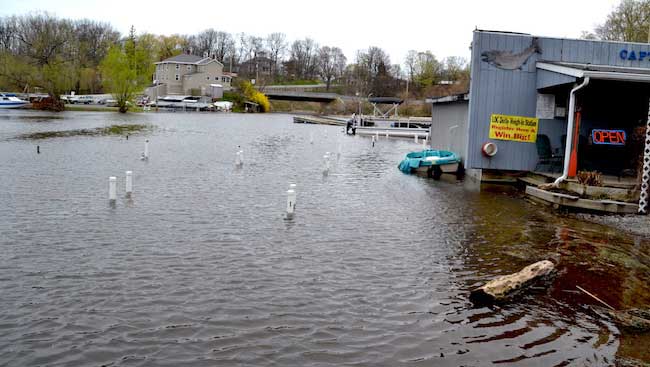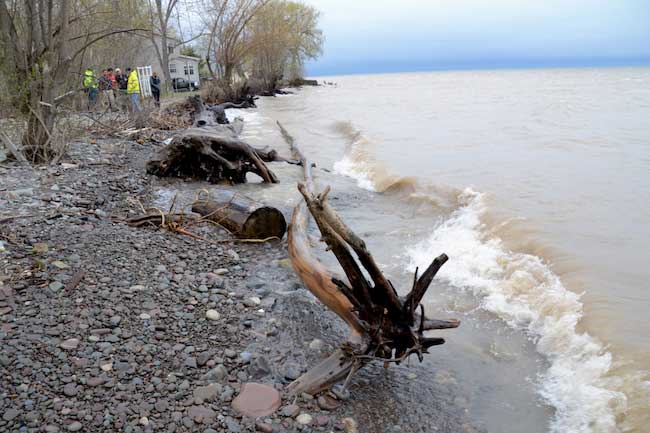Governor directs state agencies to prepare for possible flooding on Lake Ontario
Many lakeside communities, including in Orleans County, declare states of emergency
Press Release, Gov. Cuomo’s Office
Governor Cuomo today has directed state agencies to assist local communities in Cayuga, Jefferson, Monroe, Niagara, Orleans, and Wayne counties for possible flooding issues due to rising water levels on Lake Ontario and is urging all residents in the region to prepare for flooding.
At the Governor’s direction, sandbags have already been deployed to the region and have been filled to be ready for placement in lower elevation areas.
In some areas, sandbags have been pre-positioned in locations that have previously experienced flooding in the past few days and weeks. Other state assets have been staged at the regional stockpile in Monroe County.
Currently, there have been no reported significant issues in the region, however out of an abundance of caution, communities are preparing for additional lake rises.
“After significant rain and runoff, we are seeing the waters on Lake Ontario rise to higher than normal levels,” Governor Cuomo said. “While there is no current danger to residents in the surrounding areas, I am directing state agencies to assist our local officials and for those who live in the area to prepare for potential flooding and stay tuned to local weather forecasts.”
Lake Ontario is currently 18 inches above average for this time of year according to the U.S. Army Corp of Engineers, and expectations are that the level will continue to rise into May. The Army Corps of Engineers attributed the high water levels to higher-than-usual rates of precipitation and runoff.
About 40 percent of the lake water comes from local runoff and precipitation, with the remainder flowing in through the Niagara River. To offset the rising levels, the Corps has increased outflow at the Moses-Saunders Dam on the St. Lawrence River between Massena and Cornwall, Ontario, throughout the past week.
The Division of Homeland Security and Emergency Services’ Office of Emergency Management has been in constant communication with county emergency management officials in the region. A conference call has been conducted with the Nuclear Regulatory Commission, FEMA, Exelon, and the counties in the region to discuss any effects to the nuclear power plants and there are no concerns that potential flooding would impact the plants.
DHSES has deployed one sandbag filler and 60,000 sandbags to Niagara County, 30,000 sandbags to Orleans County, one sandbag filler to Monroe County, one sandbag filler and 30,000 sandbags to Wayne County, 13,000 sandbags to the Town of Huron (Wayne), and 12,000 sandbags to the Town of Wolcott (Wayne).
Additionally, two high axle vehicles have been pre-positioned at the Chili Stockpile along with two Zodiac boats, and two additional sandbag fillers which have been moved from the Montgomery and Binghamton stockpiles. Two additional sand bag fillers have been moved to the Oriskany Stockpile from the Queensbury and JFK stockpiles along with 50,000 sandbags. The Stockpile in Chili is also fully stocked with generators, light towers, and barriers, for use throughout the potentially impacted areas.
All State Police assets, including 4x4s, high axle vehicles and boats are ready for deployment as needed. Troopers have been instructed to remain on high alert and to closely monitor flood prone areas for rising waters while on patrol.

The creeks and streams that feed Lake Ontario are also high. This photo from Thursday shows the submerged docks at Captain’s Cove in Carlton.
Local States of Emergency have been issued in the following localities:
Niagara County
Orleans County
Wayne County
Town of Wilson (Niagara County)
Town of Somerset (Niagara County)
Town of Porter (Niagara County)
Town of Newfane (Niagara County)
Town of Carlton (Orleans County)
Town of Kendall (Orleans County)
Town of Yates (Orleans County)
Town of Huron (Wayne County)
Town of Ontario (Wayne County
Town of Williamson (Wayne County)
Village of Sodus Point (Wayne County)
Special State of Emergency orders for all Wayne County bays and harbors; Sodus Bay, Port Bay, East Bay, Blind Sodus Bay, Pultneyville Harbor and Bear Creek Harbor. No wake, idle speed only. (Wayne County)
A local State of Emergency allows the issuing local chief executive to exercise powers and authorities to bring the emergency situation under control. By declaring a state of emergency, the local chief executive may issue emergency orders that they deem necessary in order to preserve life and property, such as road closures or evacuation orders.
The New York State Department of Transportation is actively preparing for high water by readying equipment and staff who will conduct flood watches, monitor bridges as water rises, and respond as needed. DOT crews have been actively working to clear culverts and drainage basins to help ensure they flow freely. The NYSDOT has 3,835 operators and supervisors statewide and is ready to respond with 1,413 large dump trucks, 325 loaders, 74 excavators, 18 graders, 10 bucket trucks, 17 vacuum trucks with sewer jets, 6 trailer mounted sewer jets, 12 water tankers, 13 water pumps, and 4 bulldozers.
The New York State Thruway Authority is monitoring for potential flooding the region and are ready to deploy additional staffing and equipment to assist with any flooding issues as they develop.
In preparation for severe weather and flooding, New York State Parks continues to actively monitor the situation and has directed the Park Police and park personnel to take appropriate action to prepare for possible flooding at State Park facilities including clearing culverts and drainage areas and preparing equipment that may be necessary to respond to flood-related issues.
The best way to receive official emergency information, which can change quickly, is to subscribe to NY-ALERT (www.nyalert.gov) the state’s free, customizable, all-hazards notification system.
Governor Cuomo urged boaters on Lake Ontario and the Saint Lawrence River to be aware of floating debris such as logs and other items that can be encountered during spring run-off conditions and high water and to pay special attention to the following safety information:
Flood Safety Preparedness:
Learn the safest route from your home or business to high, safe ground should you have to leave in a hurry. Develop and practice a family escape plan and identify a meeting place if family members become separated.
Program emergency numbers into the phones of each household member.
Make an itemized list – as well as potential photo and video documentation – of all valuables, including furnishings, clothing, and other personal property. Keep the list in a safe place.
Stockpile emergency supplies of canned food, medicine, first aid supplies, and drinking water. Store drinking water in clean, closed containers.
Have a plan for your pets.
Have a portable radio, flashlights, extra batteries, and emergency cooking equipment available.
Keep your automobile fueled. If electric power is cut off, gasoline stations may not be able to pump fuel for several days. Have a small disaster supply kit in the trunk of your car.
Find out how the location of your property relates to possible flood levels. When predicted flood levels are broadcast, you can determine if you may be flooded.
Keep materials like sandbags, plywood, plastic sheeting, and lumber handy for emergency water-proofing.
Check your insurance coverage. Homeowners’ insurance policies generally do not cover flood damages. Only flood insurance can protect your home against flood damages. You can purchase flood insurance whether or not you live in a mapped flood zone.
Travel Precautions during a Flood:
During flash flooding, your vehicle can be the biggest danger. The Centers for Disease Control and Prevention report that over half of all flood-related drownings occur when a vehicle is driven into hazardous flood water.
Do not attempt to drive over a flooded road. Turn around and go another way.
Driving through 6 inches of standing water can cause cars to lose control and stall.
Do not underestimate the destructive power of fast-moving water. A foot of rushing water can carry away a small car and it takes just two feet of fast-moving flood water to carry away most vehicles including SUVs and pick-up trucks. Water moving at two miles per hour can sweep cars off a road or bridge.
Watch for areas where rivers or streams may suddenly rise and flood, such as highway dips, bridges, and low areas.
If you are in your car and water begins to rise rapidly around you, abandon the vehicle immediately.
Flood Safety During a Flood:
Monitor the National Oceanic & Atmospheric Administration’s (NOAA) Weather Radio or your local radio and TV station broadcasts for information.
If local officials advise evacuation, do so promptly. If you are directed to a specific location, go there.
Know where shelters are located.
As a precaution prior to any flood, check basement drains to make sure they are clear and energized wires are off the floor. If flooding of a home or business has already occurred, contact your utility companies to have electricity and natural gas service turned off. In the event of flooding, never attempt to turn off electricity and natural gas service. Stay out of flooded basements. Energized wiring or outlets below the water line may pose a hazard; natural gas service in a flooded basement may also pose a danger.
Bring outside possessions, including lawn furniture, garbage cans, and other movable objects, inside the house, or tie them down securely.
If there is time, move essential items and furniture to upper floors in the house.
Disconnect electrical appliances that cannot be moved. DO NOT touch them if you are wet or standing in water.
Secure your home by locking all doors and windows.
More safety tips for staying safe before, during, and after floods and other storms can be found on the DHSES website: www.dhses.ny.gov.







































































